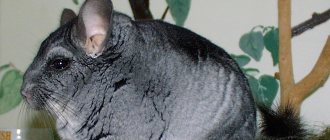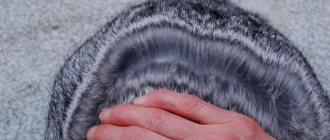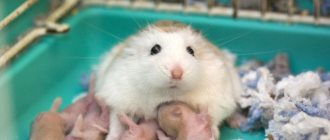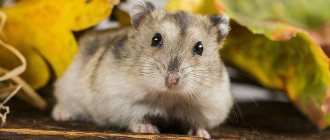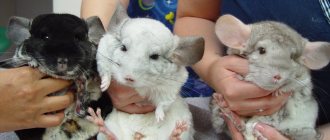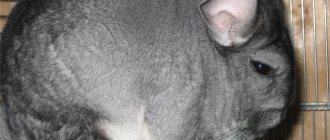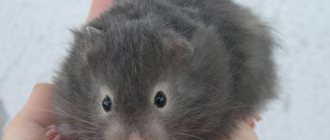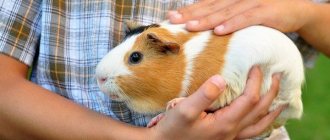- home
- Chinchilla
- Health
03/18/2019 Funny animals with beautiful fur and huge eyes are the object of love for many chinchilla breeders. Their exotic appearance, luxurious fur and long life set chinchillas apart from other rodents. Therefore, owners often decide to breed these amazing creatures.
How to understand that a chinchilla is pregnant
The onset of pregnancy requires breeders to bring the chinchilla pair closer and together. Otherwise, intimacy between the male and female will not happen, and they will be belligerent towards each other.
Experts advise planting females when they reach 12 months of age. Pregnancy ahead of schedule stops the formation of the skeleton and weight gain, which has a bad effect on the development of the female and offspring.
It is difficult to determine pregnancy at the very beginning, since night hours are suitable for mating, and an important moment is easy to miss.
A few hours after mating, the female’s vagina secretes the dried seminal fluid of the male. Evidence is provided by a vaginal plug (a small, white paraffin string) and pieces of fluff on the litter. Those who have recently given birth and first-borns may not have a cork.
The presence of traffic jams for several days indicates successful conception. An accurate sign is the absence of estrus in the female for a month, which is expressed by a change in the color of the genital organs and their swelling.
An accurate method will be x-ray and ultrasound diagnostics. An ultrasound will determine the fact of conception, and an x-ray will determine the number and position of the fetuses.
Chinchillas: breeding questions and answers (FAQ)
— How to determine the gender of a chinchilla?
Unfortunately, an inexperienced chinchilla breeder often makes mistakes when determining the sex. Call a veterinarian or a chinchilla breeder who has a lot of chinchillas and keeps them for at least two years. They will help you determine. You can, of course, write that the external genitalia of females and males are very similar in appearance, and the only difference is that in males the distance from the anus to the penis is greater than in females: But this is unlikely to help in the absence of experience in determining sex in chinchillas. Best of all, find high-quality photographs of chinchillas’ external genitalia and, when examining, compare what you actually see with the photographs. As a rule, after 3 months, the external genitalia of males look quite “convincing.”
— How many babies is born to a chinchilla on average?
According to biology, chinchillas normally have four active nipples. Hence the conclusion: four cubs is the norm. As a rule, from 1 to 3 cubs are born. Females with low milk supply, with more than 2 puppies at birth, may not have enough milk for all, so it is necessary to supplement the weakest ones. Now let's think a little. Why do captive chinchillas usually have fewer babies? There are several possible reasons: 1) All the hundreds of thousands of chinchillas living in captivity around the world are descendants of 2-3 dozen chinchillas. Those. The gene pool of this population is extremely limited. 2) Most chinchillas live in VERY cramped conditions. And ask yourself the question, who will reproduce normally in a concentration camp?! 3) Chinchillas often have an unbalanced diet: excess protein or fat leads to a decrease in fertility and survival of puppies in the first month. In good home conditions, with two litters per year, a good female regularly gives birth to 3-4 healthy puppies.
— Which mixture is suitable for feeding chinchilla puppies?
When selecting a formula for feeding (additional feeding), you should take into account the composition of chinchillas’ natural milk. Composition of chinchilla milk : fat - 14%, carbohydrates - 1.7%, protein - from 6.4% on the first day to 8% on the tenth day of lactation. It is vitally important for puppies that the female has milk for three weeks. It is best to choose a soy-based breast (human) milk replacer (this could be, for example, Similac) to avoid the danger of lactose indigestibility.
— How many times a year does a chinchilla give birth?
Chinchillas give birth infrequently (2-3 times a year) and little by little - on average 2-3 puppies. Babies born at maturity are sighted, with teeth and fur. Having dried, after 2-3 hours, they are completely ready for life and willingly “travel” around the cage.
— Until what age do chinchillas gain weight?
It is believed that animals on farms reach full size and weight by 8-9 months. According to my observations, at home, up to 8-10 months, the animal grows, so to speak, in length (increases in size), and then, up to one and a half years, “matters” (expands in breadth, gains weight), mainly due to the increase muscle mass. A prerequisite for such development is a combination of a balanced diet with sufficient exercise.
— How many grams per day should chinchillas add?
It depends on how many animals are in the litter, how large their parents are, how complete and lactogenic the female’s diet is, etc. I observed that if a large female has 4 babies, they are born weighing about 40-45 g, gain 2 g per day in the first three weeks, and add more in subsequent weeks. If the same female has 2-3 puppies in the litter, they are larger at birth (about 50-55 g) and gain 4 g in weight every day. And when 1 puppy was born, he gained 4-6 g per day almost from the day of his birth. It is dangerous if the baby not only does not gain weight, but even loses it. Or when he gains 2-4 g, he loses it again. In this case, it is necessary to supplement the diet with soy milk replacer “Similac” and find out the reasons for such weight fluctuations.
Characteristic signs of pregnancy in chinchillas
In the early stages, it is problematic to understand that a chinchilla is pregnant. Experienced breeders are guided by the following characteristics:
- drowsiness and changes in behavior: decreased activity, kind and peaceful attitude towards the owner. Before childbirth, anxiety, fear of noise and aggression towards the male appear;
- change in color of the nipples at the end of the second month: from white to pink plus slight swelling;
- significant weight gain after the eighth week: 10-15 g weekly. For control, it is recommended to record data on the gain;
- increased appetite due to an increased need for fluids, microelements and proteins;
- frequent urination. Occurs due to pressure from the growing uterus on the bladder;
- abdominal enlargement.
How long does pregnancy last in chinchillas?
The usual period is 110-115 days. It depends on:
- Number of cubs borne.
- Breed varieties.
- Personal characteristics of a female individual.
When carrying one baby, pregnancy lasts 120 days, several – up to 105 days. Chinchillas are born tiny and have a bare belly. Weight is gained by artificial or natural feeding within a few days.
Information: chinchillas are able to successfully give birth up to 15 years of age. At the same time, the average lifespan is 18 years, with good care - 28 years.
Without harm to health, individuals give up to 2 litters annually. Within a day, the female is again ready to conceive. However, against the background of a new pregnancy and hormonal imbalance, she is capable of killing her offspring. Therefore, the male is separated from her for six months.
Baby care
The body weight of newborn chinchillas ranges from 30 to 70 grams and depends on heredity, litter size and mother’s feeding during pregnancy. Full-term chinchillas are born with teeth erupted, sighted, covered with fur, and capable of independent movement. A week after birth, the puppy already tries food, but continues to feed on milk until 1.5–2 months.
While breastfeeding, the chinchilla is prone to losing weight, so she needs to be provided with very good nutrition. Milk can be added to the diet.
The first 2 weeks are considered critical for the cubs. The room temperature should be maintained around 20° C.
The young are separated from their mother at the age of two months, and the babies weigh 200–250 grams. In general, chinchillas are very good mothers, and problems with caring for their offspring rarely arise. Healthy babies are cheerful, calm, and wag their tails. The weak have no appetite and are lethargic. The reason for this may be a lack of milk from the mother chinchilla. In this case, the cubs are fed artificially. Unfortunately, there are also situations when babies are left orphans due to the death of their mother or the female does not have milk (this can happen due to stress or illness), and hungry babies squeak heavily and become weak. If this happens, then the puppies have to be fed themselves - for this you need to prepare a mixture similar in fat content to chinchilla milk. For these purposes, it is better to choose lactose-free infant formula or milk powder for kittens. You can also feed chinchillas with boiled cow's milk, or better yet, goat's milk, adding a drop of butter. When the tummy is bloated, it is recommended to do a light massage.
Chinchillas are fed from a pipette or from a syringe without a needle; it is more convenient to use an insulin syringe. The mixture is calculated as follows: 10 ml per 50 grams of baby’s weight. That is, when feeding every two hours, a chinchilla weighing 50 grams should receive about 0.8–0.9 ml of the mixture at a time. If the mixture is suitable, then the babies begin to gain weight, they should not have diarrhea or constipation. During the first week, puppies are fed every two hours; in the second week of life, the interval between feedings can be increased to three hours. If the puppies are orphaned, they additionally require heating using a heating pad or a bottle of warm water.
Should the male be separated from the female after giving birth? Males are different and can treat babies with aggression
And even the kindest male can run over or injure a chinchilla through negligence, simply by jumping poorly. Plus, almost after giving birth, the male can cover the female again, and this, of course, will not benefit her at all. It is undesirable to allow multiple births of offspring in a female, since frequent births exhaust the body
Of course, the female is capable of bearing offspring three times a year, but the cubs may be born weak and non-viable.
How many children do chinchillas have?
Two weeks before giving birth, the female's genital loop swells and becomes crimson. Pregnancy in chinchillas ends with the birth of 1-3 children. Adults bring up to 4-6 chinchillas. In the latter case, there is a possibility of death of weak cubs, since stronger ones deprive them of food.
A pair of nipples is intended for feeding the cubs, less often - two, although the anatomical structure suggests three pairs. Therefore, the salvation of underfed chinchillas depends on the owner. An artificial formula is suitable for feeding.
Sexual maturity
The female is ready to mate at the age of 8 months, and the male is already at 6-7. A chinchilla at this age should already weigh more than 500 grams; if she has not gained that weight, then she is not yet ready for mating, because it will be difficult for her to bear offspring.
On average, chinchillas continue to give birth until they are 10-12 years old. A female can bring up to 2-3 offspring per year, and the number of cubs will always be different, from 1 to 5. There is no need to continuously mate animals, otherwise the female will age faster and lose her health.
Chinchilla birth chart
To make it easy to determine the date of birth, there is a simple table of average pregnancy periods. The error in the table is due to the fact that signs of pregnancy are not immediately noticeable, and ranges from one to four days.
The top lines correspond to the mating date (taking into account the error), the bottom lines correspond to the day of birth. For example, if conception occurred on January 6, the chinchillas will be born presumably on April 26. For ease of reference, the required date is highlighted in black or red.
Table of pregnancy and birth in chinchillas:
| January April | 1 2 3 4 5 6 7 8 9 10 11 12 13 14 15 16 17 18 19 20 21 22 23 24 25 26 27 28 29 30 31 21 22 23 24 25 26 27 28 29 30 1 2 3 4 5 6 7 8 9 10 11 12 13 14 15 16 17 8 19 20 21 |
| February May | 1 2 3 4 5 6 7 8 9 10 11 12 13 14 15 16 17 18 19 20 21 22 23 24 25 26 27 28 22 23 24 25 26 27 28 29 30 31 1 2 3 4 5 6 7 8 10 11 12 13 14 15 16 17 18 |
| March June | 1 2 3 4 5 6 7 8 9 10 11 12 13 14 15 16 17 18 19 20 21 22 23 24 25 26 27 28 29 30 31 19 20 21 22 23 24 25 26 27 28 29 30 1 2 3 4 5 6 7 8 9 10 11 12 13 14 15 16 17 18 19 |
| April July | 1 2 3 4 5 6 7 8 9 10 11 12 13 14 15 16 17 18 19 20 21 22 23 24 25 26 27 28 29 30 20 21 22 23 24 25 26 27 28 29 30 31 1 2 3 4 5 6 7 8 9 10 11 12 13 14 15 16 17 18 |
| May August | 1 2 3 4 5 6 7 8 9 10 11 12 13 14 15 16 17 18 19 20 21 22 23 24 25 26 27 28 29 30 31 19 20 21 22 23 24 25 26 27 28 29 30 31 1 2 3 4 5 6 7 8 9 10 11 12 13 14 15 16 17 18 |
| June September | 1 2 3 4 5 6 7 8 9 10 11 12 13 14 15 16 17 18 19 20 21 22 23 24 25 26 27 28 29 30 19 20 21 22 23 24 25 26 27 28 29 30 1 2 3 4 5 6 7 8 9 10 11 12 13 14 15 16 17 18 |
| July October | 1 2 3 4 5 6 7 8 9 10 11 12 13 14 15 16 17 18 19 20 21 22 23 24 25 26 27 28 29 30 31 19 20 21 22 23 24 25 26 27 28 29 30 31 1 2 3 4 5 6 7 8 9 10 11 12 13 14 15 16 17 18 |
| August November | 1 2 3 4 5 6 7 8 9 10 11 12 13 14 15 16 17 18 19 20 21 22 23 24 25 26 27 28 29 30 31 19 20 21 22 23 24 25 26 27 28 29 30 1 2 3 4 5 6 7 8 9 10 11 12 13 14 15 16 17 18 19 |
| September December | 1 2 3 4 5 6 7 8 9 10 11 12 13 14 15 16 17 18 19 20 21 22 23 24 25 26 27 28 29 30 20 21 22 23 24 25 26 27 28 29 30 31 1 2 3 4 5 6 7 8 9 10 11 12 13 14 15 16 17 18 |
| October January | 1 2 3 4 5 6 7 8 9 10 11 12 13 14 15 16 17 18 19 20 21 22 23 24 25 26 27 28 29 30 31 19 20 21 22 23 24 25 26 27 28 29 30 31 1 2 3 4 5 6 7 8 9 10 11 12 13 14 15 16 17 18 |
| November February | 1 2 3 4 5 6 7 8 9 10 11 12 13 14 15 16 17 18 19 20 21 22 23 24 25 26 27 28 29 30 19 20 21 22 23 24 25 26 27 28 1 2 3 4 5 6 7 8 9 10 11 12 13 14 15 16 17 18 19 20 |
| December March | 1 2 3 4 5 6 7 8 9 10 11 12 13 14 15 16 17 18 19 20 21 22 23 24 25 26 27 28 29 30 31 21 22 23 24 25 26 27 28 29 30 31 1 2 3 4 5 6 7 8 9 10 11 12 13 14 15 16 17 18 19 20 |
Formation of a couple
Before mating, you need to select a pair, paying attention to the following points:
- the animals must match each other according to breeding data;
- have good pedigrees;
- have good health;
- have similar color and quality of fur;
- the couple should not consist of close relatives up to the third generation of kinship.
When forming couples, it is also necessary to take into account the age of the partners. Females reach sexual maturity at 6-9 months. It is advisable to choose a male that is 2-3 months older for her. If the female is older than a year, on the contrary, it is recommended to choose a male 2-3 months younger for her. But this condition is not mandatory.
To give birth to viable offspring, the female and male must be in excellent physical shape. You need to know that emaciated or, on the contrary, obese animals can produce sick or weakened puppies. It is quite possible that the female will not become pregnant at all.
Before mating, you should determine the relationship of the partners to each other. To do this, they are first placed in different cages, but placed at a close distance. This way the animals will be able to get somewhat used to each other. Then an attempt is made to place the couple together. If a calm relationship has been established between the animals, they do not quarrel or fight, then the replanting was successful.
Females are generally larger, stronger and more aggressive than males. If there is no peaceful life between the animals, on the contrary, there is aggression, then the failed pair should be separated and other options for mating should be selected.
Chinchillas recognize each other by smell, and if one animal has already been living in a cage for some time, then it may try to drive the newcomer out of it. If this happens, there are several ways to reduce the old-timer's aggressiveness. For example, placing a cage with a new animal next to an old cage. In 2-3 days, the animals will get used to each other’s smell, after which you can try to place them together, and if unsuccessful, place them again, changing places. After a few days, you can try again.
You can try placing a small (transport) cage with a newcomer inside a large cage with an old resident for 4-5 hours. The animals will make contact, but will not be able to fight.
A successful option may be to lock the old resident for 3-4 hours in a small cage located inside the large one into which the newcomer is released. The latter, moving freely, will leave its smell in all corners of the cage and accustom the “owner” to it. When the old-timer is finally released from the small cage, he will treat the newcomer with “respect.”
Usually fewer problems arise when forming a pair of young individuals. Animals most easily get used to each other at the age of six months, immediately after reaching sexual maturity, and they can be used for breeding until they reach the age of ten.
The time for active mating of animals in natural conditions is from November to May, in captivity – from November to April. By changing the behavior of animals, one can determine their readiness to reproduce. The male begins to actively court the female, running after her around the cage, snorting loudly, and wagging his tail. The female is restless, eats poorly, and scatters food around the cage. All these signs indicate that the couple has formed, and it will not delay the start of reproduction.
Chinchillas rut approximately every 40-41 days. This period can vary from 30 to 50 days. The duration of the rut is from two to seven days. The female accepts the male’s “signs of attention”; during estrus, she lifts up the back of her body and seems to stretch out in front of her suitor, indicating her readiness to mate.
How to care for a pregnant chinchilla
To successfully complete the birth, a pregnant chinchilla needs the following conditions:
- an enclosure free of toys and shelves to avoid injury to newborns. Instead of an enclosure, a low cage with a gap of 10 mm between the bars is suitable (so that the cubs do not end up outside);
- protection from noise and harsh light, plus maintaining silence in the room;
- reduction of walks. It is not recommended to pick up an animal. If necessary, the owner can calm the female by stroking her belly. It is forbidden to lift a chinchilla by the tail, as fright from this can lead to miscarriage;
- placing the male a few weeks before birth;
- X-rays during the prenatal period (contraindicated in shy individuals);
- daily cleaning and flooring made of wood or hay to insulate the floor;
- no swimming three to four days before the event and the next few weeks;
- cleaning the enclosure a couple of days after a successful outcome.
What to feed a pregnant chinchilla
Females that bear cubs need high-quality and fresh food.
Products you need to add to the menu:
- chopped plants (alfalfa, calendula and strawberries) plus beebread for good lactation;
- barley or oat sprouts, due to the presence of vitamin E (its deficiency causes fetal malformations or miscarriages);
- pieces of apples 15-20 days before birth;
- special food from a veterinarian store with a high protein content, for better lactation and easy pregnancy.
The diet will be supplemented with greens, a mixture of powdered milk and cereal, and rose hips. Additionally, calcium gluconate is prescribed to support the skeleton.
Thyme and mint have a negative effect on lactation; it is better to exclude them. You will also have to reduce roughage (corn cobs, straw and hay) by about a quarter, increasing the amount of juicy fruits, vegetables and protein (cottage cheese, yogurt, meat and bone meal, etc.).
Signs and preparation for impending birth in a chinchilla
After establishing the breeding day, the chinchilla breeder must:
- Calculate the day of birth using the table.
- Place the male.
- Cover the nest with a dark cloth for a comfortable atmosphere.
- Prepare hydrogen peroxide, a solution of ascorbic acid and glucose, gamavit, ethamsylate, oxytocin, dicinone, calcium gluconate for injection, napkins and diapers, disposable syringes, milk substitute, saline solution and an electric fireplace for heating.
- Change the water daily.
- Agree with the veterinarian about possible obstetric care.
Signs of imminent labor
- Female anxiety. It is aggravated by loud noises and stress, which sometimes leads to early labor and even harm to the newborn.
- The animal uses fluff from its belly and straw a couple of days before the event to build a nest. To prevent the litter from being thrown away, the nest house is placed on the floor with the hole facing up. The owner himself can insulate the nest.
- Inactivity: the animal prefers to lie on its back or side.
- In 2-4 days, the female bends and, as it were, spreads along the floor: this helps the fetus move towards the birth canal.
- A few hours before the babies appear, the stomach drops down, the genital loop turns pink and swells, and the ribs retract.
- Body weight decreases to 25 g, rectal temperature decreases by one to one and a half degrees.
How chinchillas give birth
Chinchillas usually give birth at 5-7 am. Before this, they hardly eat for several days.
False labor in chinchillas occurs within 1-3 days: this is how the body prepares for the birth of babies. The animal stretches, stands on its hind legs, contracts its stomach and draws in its sides, and then rests.
Childbirth takes place without the help of the owner, and lasts several hours. The female rises on her legs and pushes, pushing out the fetus and the baby's place, which she later eats.
Puppies are born sighted and covered with fur. The mother licks them, feeds them and covers them with her body so that they quickly dry and warm up. Her colostrum appears instantly, milk - on days 3-5. Vitamin injections are used to suppress milk flow.
If chinchillas give birth to dead puppies, this causes stress, and you need to quickly get the non-viable offspring out of the cage. If a puppy is born premature, cotton wool soaked in a decoction of chamomile or calendula will help open its eyes. It is used to wipe the muzzle from the nose to the corner of the eyes.
How babies are born
Chinchilla offspring are born weighing 30–60 g with open eyes and teeth and can almost immediately move independently over a short distance. Usually after some time they hide under their mother to dry out and warm up.
At first, babies eat mother's milk. Lactation begins one day after birth. Newborns feed on colostrum for 24 hours.
If for some reason they miss him, the owner will have to feed the kids. To do this, prepare a mixture of condensed milk without sugar and chamomile infusion in a 1:2 ratio. It is warmed to room temperature. Feeding is done with a syringe without a needle for the first 7 days every 2 hours, the second 7 - at an interval of 4 hours, the third week - at an interval of 6 hours.
At 2 months, small chinchillas will weigh about 80-90 g, at 12 months - 120-130 g. They are ready for independent life from 3 months.
So, if you are planning to breed chinchillas, then you need to prepare for this process, namely: create the required conditions (for example, purchase an additional cage for the male, who will need to be placed during pregnancy and the first time of feeding the babies); find a veterinarian who could provide assistance if necessary; decide whether you can provide the female with high-quality nutrition, care and observation during pregnancy, as well as provide artificial supplementary feeding to the babies, if necessary.
How to help a chinchilla during childbirth
The process itself does not require intervention. However, difficult births also occur in the following cases:
- Premature sagging;
- incorrect position of the fetus;
- maternal injury;
- two or more births per year.
Attention: labor longer than five hours requires an urgent caesarean section, otherwise the mother will die from heavy bleeding along with her babies.
If the animal gives birth to cubs for longer than 2 hours, it is allowed to drink warm sugar syrup and massage the abdomen from the navel to the pelvis. If the fetus comes out with difficulty, you need to lubricate the body with oil (based on Vaseline) and carefully pull it out, turning it clockwise within seconds of pushing.
What to feed a chinchilla after giving birth
When chinchilla labor ends with the appearance of babies, it’s time to think about the diet of the new mother.
The basis of nutrition will be calcium and protein. Fruits, nuts, rose hips, sprouted grains and herbs (alfalfa, vetch and nettle) are required.
You can’t do without dry (fat-free) milk, dairy products, meat and bone meal, calcium gluconate, berries and vitamin supplements.
The presence of liquid in the drinking bowl will help the individual cope with thirst. The bath is placed closer to the nest so that the female can easily reach it.
Readiness for mating (estrus)
Like many animals, female chinchillas have a period of estrus (hunting) when they are ready to mate and, moreover, desire it. On average, estrus lasts from 2 to 5 days, then the mating process may become unsuccessful.
Determining whether a chinchilla has started hunting is not difficult. Her behavior gives her away very much; she begins to throw everything around and creates complete chaos in her cage. Along with active behavior, the female eats very little or not at all.
The second sign is external signs. The genitals swell and become bright pink.
How to Handle Cubs
When the female leaves the nest after giving birth, the owner needs to remove the puppies with disinfected hands and remove the dead ones (if any). Hand washing is only allowed with laundry soap; perfumed soap will leave a smell on the cubs and scare away the female.
Babies left outside the nest need to be dried, warmed, given a drink from a pipette and placed with their mother.
After 24 hours, all newborns need to be weighed: the weight norm is from 30 to 70 g. The procedure is carried out every day at the same hour. Usually puppies gain one gram at a time. If it is less, additional feeding will help, or switching to artificial feeding (if the chinchilla has a small amount of milk).
Children are separated from their mother after 30 days, grouping heterosexual flocks. Young animals are fed with boiled and warm cow's milk for up to six months.
Is it possible to touch newborn chinchillas?
To examine the cubs after birth, you need to thoroughly wash your hands with laundry soap to avoid infection. Any other means leave a smell that the mother will perceive as foreign, and there is a danger that she will stop feeding the children or even bite them.
At first, try to handle the babies as little as possible, remembering to wash them. It is better if only the owner does this to avoid odors, the possibility of infection or injury to the tiny animal. When the cubs are a month old, interaction with humans will be useful for them: in the future they will become sociable and affectionate.


